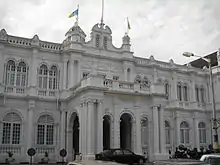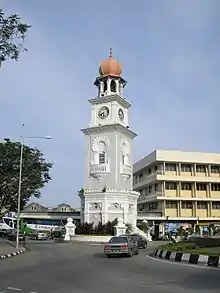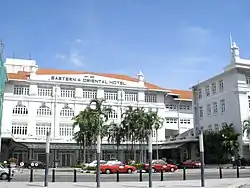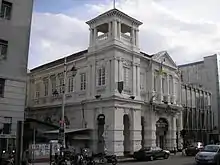Architecture of Penang
The architecture of Penang reflects the 171 years of British presence on the island, coalescing with local, Chinese, Indian, Islamic and other elements to create a unique and distinctive brand of architecture. Along with Malacca, Penang is an architectural gem of Malaysia and Southeast Asia. Unlike Singapore, also a Straits Settlement, where many heritage buildings had to make way for modern skyscrapers and high-rise apartments due to rapid development and acute land scarcity, Penang's architectural heritage has enjoyed a better fate. Penang has one of the largest collections of pre-war buildings in Southeast Asia.[1] This is for the most part due to the Rent Control Act which froze house rental prices for decades, making redevelopment unprofitable. With the repeal of this act in 2000 however, property prices skyrocketed and development has begun to encroach upon these buildings, many of which are in a regrettable state of disrepair.[2] The government in recent years has allocated more funding to finance the restoration of a number of derelict heritage buildings, most notably Suffolk House, City Hall and historic buildings in the old commercial district.








Colonial style
Fort Cornwallis, built by Francis Light as a defensive measure when he first gained possession of Penang island, is the oldest British structure in Penang.[3] Located where the Esplanade now stands and where he first landed on the island, it was originally built of wood and was subsequently replaced by brick.
The architecture of the Suffolk House is of the Anglo-Indian Garden House style, commonly found in British India. It sits upon land once owned by Light as his pepper estate whereupon light built a humble timber and attap garden house, noted in letters from visiting friends. The current colonnaded Euro-Indian Georgian building was thought to have been built by W. E. Phillips following his purchase of the land from Light's former partner Scott. Nestled on the bank of the Ayer Itam River, the building was used by Governor Bannerman—Phillip's father-in-law—amongst other Governors of Penang and also the Governors of the Straits Settlements. It was occupied by the Imperial Japanese administration during the Second World War. Later, it was utilised by the Methodist Boys' School which was built next to the house. Today, having weathered years of neglect, it is being meticulously restored with the help of researchers from the United Kingdom, Malaysia and Australia.
Other distinguished buildings from the colonial period include the City Hall, the Town Hall, the Eastern and Oriental Hotel (Penang's first grand hotel, older than its Singaporean sister the Raffles Hotel by two years), the Mansion, the Garage, the Standard Chartered Bank building, the HSBC building, the Southern Bank building, the Uplands International School building, as well as the great trading houses of Weld Quay. Many of these render the eclectic architectural styles of the Victorian and Georgian eras as well as Art Deco and Anglo-Indian.
Chinese influence
Chinese immigrants brought with them architecture from their ancestral land as can be seen in the many Chinese temples and clan houses. Examples that stand out include the Cheong Fatt Tze Mansion (also known as the Blue Mansion), built by the namesake Qing-dynasty Chinese immigrant who was a hugely successful trader and community leader; the Kuan Yin Temple, the Khoo Kongsi, and the intricate clan house of the influential Khoo clan. The spectacular temple of Kek Lok Si at the foothill of Penang Hill is the largest Buddhist temple in Southeast Asia. Known as the Temple of Ten Thousand Buddhas, it was largely built by artisans and worksmen from China in the 19th century. A great many of the shophouses and residences found in George Town were built in the style of Straits-Chinese architecture with their very recognisable red terracotta roofs.
Nouveau riche Chinese millionaires of the time built themselves stately mansions along the famed Millionaires' Row of Northam Road (now Sultan Ahmad Shah Road). One of the most famous of them still standing today is the Yeap mansion Homestead, resplendent in white. The holiday palace of the Sultan of Kedah, Istana Kedah is also located on the same stretch.
Towkay Chung Thye Phin, last Kapitan China of Penang and Perak, was responsible for two exceptional pieces of architecture. The first was the fabled Chung Thye Phin Mansion where Gurney Drive meets Northam Road (No 2 Kelawai Road). People walking through the building found themselves strolling along subterranean passageways and chambers, gazing up at a clear glass dining room ceiling revealing live fish or marvelling at the art deco interiors of its rooms. After the death of its owner, the mansion was sold and turned into a hotel (The Shanghai Hotel) famous for its local music and "joget" dances. It was eventually demolished and on its footprint now stands an imposing condominium (1 Gurney Drive). On another part of the island, Chung designed Relau Villa, his holiday resort. The villa was equipped with a swimming pool ringed by private and other types of rooms. Its derelict structure can still be seen and explored today at Taman Metropolitan, Relau. According to family history, Kapitan Chung Thye Phin was inspired by the artistic canals of Venice and the enchanting ponds and lakes of China when he designed the swimming-pool, which was constructed by Mr. B. H. Ung, the first Chinese architect to make use of reinforced concrete buildings in the community, the Ban Hin Lee Bank being a particularly notable example.
Other influences
Indian Muslims made their mark in the Kapitan Keling Mosque located on its namesake road.
The Siamese and Burmese community of Penang built their imposing temples which portray architectural traditions of their two home nations. Three of the most famous examples are the Wat Chaiyamangkalaram (better known as the Sleeping Buddha Temple), Wat Buppharam and the Dhammikarama Burmese Temple. The Sri Lankan community had also built a temple known as Mahindarama Buddhist Temple in Penang.
Protection
Penang has been submitting to list George Town on the UNESCO World Heritage Site since year 2000, which hope to put the state in a better position to protect her rich cultural heritage.[4] On 7 July 2008, George Town and Malacca are formally inscribed as UNESCO World Heritage Sites with the title of Historic Cities of the Straits of Malacca.
George Town and Malacca have developed over 500 years of trading and cultural exchanges between East and West in the Straits of Malacca. The influences of Asia and Europe have endowed the towns with a specific multicultural heritage that is both tangible and intangible. With its government buildings, churches, squares and fortifications, Malacca demonstrates the early stages of this history originating in the 15th-century Malay sultanate and the Portuguese and Dutch periods beginning in the early 16th century. Featuring residential and commercial buildings, George Town represents the British era from the end of the 18th century. The two towns constitute a unique architectural and cultural townscape without parallel anywhere in East and Southeast Asia.[5]
See also
References
- "Tourism Penang". Archived from the original on 2007-12-13. Retrieved 2007-12-16.
...one of the largest collections of 19th, and early 20th century buildings in Southeast Asia.
- "The end for straits house ?". NST Online. Archived from the original on September 21, 2008. Retrieved 2007-12-16.
- "Historic George Town". Archived from the original on 26 November 2007. Retrieved 2007-12-16.
...the oldest surviving structure in Penang.
- "Malacca, Penang asked to resubmit heritage site applications to Unesco". The Star. 2007-07-18. Retrieved 2007-12-16.
- "Eight new sites, from the Straits of Malacca, to Papua New Guinea and San Marino, added to UNESCO's World Heritage List". UNESCO. 2008-07-07. Archived from the original on 9 July 2008. Retrieved 2008-07-07.